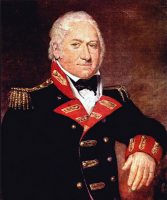










Major General Henry Shrapnel (1761 –1842) was a British Army officer whose name has entered the English language as the inventor of the "shrapnel shell".
In 1784, Henry Shrapnel invented the shrapnel shell for cannons, which was later adopted by the British army in 1803 for cannons and rifles.
Early Scatter Projectiles
Before Henry Shrapnel invented his weapon there were several earlier kinds of scatter projectiles.
There was case shot, or canister, first used at Constantinople in 1453. The name "case shot" comes from the projectile's case usually made of metal, which was filled with scrap, musket balls, or slugs.
Similiar to the case shot was the grape shot, without a metal case, made from larger iron balls. The grape shot was named from the grape-like appearance of the iron balls. The grape shop could disable men at almost 900 yards and was used extensively during the 1700's. Eventually, it was replaced by case shot type scatter projectiles, which was more effective at shorter ranges (400 to 700 yards).
The spherical case shot was more effective because of its bursting shell. It was the direct forerunner of the shrapnel used so much in World War I, invented by Henry Shrapnel in 1784. Henry Shrapnel's invention was the first air-bursting case shot which, in technical words, "imparted directional velocity" to the bullets it contained.
Henry Shrapnel's new shell was first used by the British against the French in 1808, however, it was not named after Henry Shrapnel until 1852.
Henry Shrapnel & Shrapnel Scatter Projectiles
The first photo to the right depicts two shrapnel balls from a World War I era 75-mm. shrapnel projectile and a fragment from a World War I era 75-mm. high explosive shell.
The intended destructive effect of the shrapnel projectile against men and animals came from the shrapnel balls. The projectile casing, which merely acted as a carrier for the shrapnel balls, was not designed to fracture or fragment. Some World War I era shrapnel projectiles contained a mixture of two sized balls. The smaller balls, intended for anti-personnel use, constituted approximately ninety per cent of the shrapnel round. The remaining percentage of larger balls were included to disable or kill horses.
The intended destructive effect of high explosive rounds came from the action of the high explosive charge coupled with the fragmentation of the projectile casing. Whereas a shrapnel round was intended to kill or injure people and animals, high explosive rounds were originally designed to damage or destroy inanimate objects such as buildings and field guns.